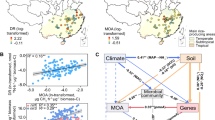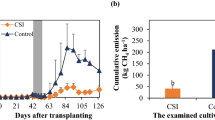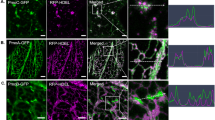Abstract
Methanotrophs in the rhizosphere play an important role in global climate change since they attenuate methane emission from rice field ecosystems into the atmosphere. Most of the CH4 is emitted via transport through the plant gas vascular system. We used this transport for stable isotope probing (SIP) of the methanotrophs in the rhizosphere under field conditions and pulse-labelled rice plants in a Chinese rice field with CH4 (99% 13C) for 7 days. The rate of 13CH4 loss rate during 13C application was comparable to the CH4 oxidation rate measured by the difluoromethane inhibition technique. The methanotrophic communities on the roots and in the rhizospheric soil were analyzed by terminal-restriction fragment length polymorphism (T-RFLP), cloning and sequencing of the particulate methane monooxygenase (pmoA) gene. Populations of type I methanotrophs were larger than those of type II. Both methane oxidation rates and composition of methanotrophic communities suggested that there was little difference between urea-fertilized and unfertilized fields. SIP of phospholipid fatty acids (PLFA-SIP) and rRNA (RNA-SIP) were used to analyze the metabolically active methanotrophic community in rhizospheric soil. PLFA of type I compared with type II methanotrophs was labelled more strongly with 13C, reaching a maximum of 6.8 atom-%. T-RFLP analysis and cloning/sequencing of 16S rRNA genes showed that methanotrophs, especially of type I, were slightly enriched in the ‘heavy’ fractions. Our results indicate that CH4 oxidation in the rice rhizosphere under in situ conditions is mainly due to type I methanotrophs.
Similar content being viewed by others
Log in or create a free account to read this content
Gain free access to this article, as well as selected content from this journal and more on nature.com
or
References
Bedard C, Knowles R . (1989). Physiology, biochemistry, and specific inhibitors of CH4, NH4+, and CO oxidation by methanotrophs and nitrifiers. Microbiol Rev 53: 68–84.
Bligh EG, Dyer WJ . (1969). A rapid method for total lipid extraction and purification. Can J Biochem Physiol 37: 911–917.
Bodelier PLE, Frenzel P . (1999). Contribution of methanotrophic and nitrifying bacteria to CH4 and NH4+ oxidation in the rhizosphere of rice plants as determined by new methods of discrimination. Appl Environ Microbiol 65: 1826–1833.
Bodelier PLE, Laanbroek HJ . (2004). Nitrogen as a regulatory factor of methane oxidation in soils and sediments (Review). FEMS Microbiol Ecol 47: 265–277.
Bodelier PLE, Roslev P, Henckel T, Frenzel P . (2000). Stimulation by ammonium-based fertilizers of methane oxidation in soil around rice roots. Nature 403: 421–424.
Boschker HTS, Middelburg JJ . (2002). Stable isotopes and biomarkers in microbial ecology (Review). FEMS Microbiol Ecol 40: 85–95.
Boschker HTS, Nold SC, Wellsbury P, Bos D, DeGraaf W, Pel R et al. (1998). Direct linking of microbial populations to specific biogeochemical processes by 13C-labelling of biomarkers. Nature 392: 801–805.
Bosse U, Frenzel P, Conrad R . (1993). Inhibition of methane oxidation by ammonium in the surface layer of a littoral sediment. FEMS Microbiol Ecol 13: 123–134.
Bowmann JP, Sly LI, Nichols PD, Hayward AC . (1993). Revised taxonomy of the methanotrophs: description of Methylobacter gen. nov., emendation of Methylococcus, validation of Methylosinus and Methylocystis species, and a proposal that the family Methylococcaceae includes only the group I methanotrophs. Int J Syst Bacteriol 43: 735–753.
Bussmann I, Pester M, Brune A, Schink B . (2004). Preferential cultivation of type II methanotrophic bacteria from littoral sediments (Lake Constance). FEMS Microbiol Ecol 47: 179–189.
Cai ZC . (1997). A category for estimate of CH4 emission from rice paddy fields in china. Nutrient Cycling in Agroecosystems 49: 171–179.
Cai ZC, Tsuruta H, Gao M, Xu H, Wei CF . (2003). Options for mitigating methane emission from a permanently flooded rice field. Glob Chang Biol 9: 37–45.
Conrad R, Klose M, Claus P . (2002). Pathway of CH4 formation in anoxic rice field soil and rice roots determined by 13C-stable isotope fractionation. Chemosphere 47: 797–806.
Conrad R, Schütz H . (1988). Methods of studying methanogenic bacteria and methanogenic activities in aquatic environments. In: Austin B (ed). Methods in Aquatic Bacteriology. Wiley: Chichester. pp 301–343.
Dan JG, Krüger M, Frenzel P, Conrad R . (2001). Effect of a late season urea fertilization on methane emission from a rice field in Italy. Agric Ecosyst Environ 83: 191–199.
Dedatta SK, Buresh RJ . (1989). Integrated nitrogen management in irrigated rice. Adv Soil Sci 10: 143–169.
Dedysh SN, Belova SE, Bodelier PLE, Smirnova KV, Khmelenina VN, Chidthaisong A et al. (2007). Methylocystis heyeri sp. nov., a novel type II methanotrophic bacterium possessing ‘signature’ fatty acids of type I methanotrophs. Int J Syst Evol Microbiol 57: 472–479.
Dedysh SN, Liesack W, Khmelenina VN, Suzina NE, Trotsenko YA, Semrau JD et al. (2000). Methylocella palustris gen. nov., sp nov., a new methane-oxidizing acidophilic bacterium from peat bags, representing a novel subtype of serine-pathway methanotrophs. Int J Syst Evol Microbiol 50: 955–969.
Dunfield PF, Yuryev A, Senin P, Smirnova AV, Stott MB, Hou SB et al. (2007). Methane oxidation by an extremely acidophilic bacterium of the phylum Verrucomicrobia. Nature 450: 879–882.
Eller G, Frenzel P . (2001). Changes in activity and community structure of methane-oxidizing bacteria over the growth period of rice. Appl Environ Microbiol 67: 2395–2403.
Eller G, Krüger M, Frenzel P . (2005). Comparing field and microcosm experiments: a case study on methano- and methylo-trophic bacteria in paddy soil. FEMS Microbiol Ecol 51: 279–291.
Evershed RP, Crossman ZM, Bull ID, Mottram H, Dungait JAJ, Maxfield PJ et al. (2006). C-Labelling of lipids to investigate microbial communities in the environment (Review). Curr Opinion Biotechnol 17: 72–82.
Groot TT, VanBodegom PM, Harren FJM, Meijer HAJ . (2003). Quantification of methane oxidation in the rice rhizosphere using 13C-labelled methane. Biogeochemistry 64: 355–372.
Hanson RS, Hanson TE . (1996). Methanotrophic bacteria. Microbiol Rev 60: 439–471.
Henckel T, Friedrich M, Conrad R . (1999). Molecular analyses of the methane-oxidizing microbial community in rice field soil by targeting the genes of the 16S rRNA, particulate methane monooxygenase, and methanol dehydrogenase. Appl Environ Microbiol 65: 1980–1990.
Hoffmann T, Horz HP, Kemnitz D, Conrad R . (2002). Diversity of the particulate methane monooxygenase gene in methanotrophic samples from different rice field soils in China and the Philippines. Syst Appl Microbiol 25: 267–274.
Holmes AJ, Costello A, Lidstrom ME, Murrell JC . (1995). Evidence that particulate methane monooxygenase and ammonia monooxygenase may be evolutionarily related. FEMS Microbiol Lett 132: 203–208.
Horz HP, Rich V, Avrahami S, Bohannan BJM . (2005). Methane-oxidizing bacteria in a California upland grassland soil: diversity and response to simulated global change. Appl Environ Microbiol 71: 2642–2652.
Horz HP, Yimga MT, Liesack W . (2001). Detection of methanotroph diversity on roots of submerged rice plants by molecular retrieval of pmoA, mmoX, mxaF, and 16S rRNA and ribosomal DNA, including pmoA-based terminal restriction fragment length polymorphism profiling. Appl Environ Microbiol 67: 4177–4185.
Huber T, Faulkner G, Hugenholtz P . (2004). Bellerophon: a program to detect chimeric sequences in multiple sequence alignments. Bioinformatics 20: 2317–2319.
Islam T, Jensen S, Reigstad LJ, Larsen O, Birkeland NK . (2008). Methane oxidation at 55°C and pH 2 by a thermoacidophilic bacterium belonging to the Verrucomicrobia phylum. Proc Natl Acad Sci USA 105: 300–304.
Krüger M, Frenzel P . (2003). Effects of N-fertilisation on CH4 oxidation and production, and consequences for CH4 emissions from microcosms and rice fields. Glob Chang Biol 9: 773–784.
Krüger M, Frenzel P, Conrad R . (2001). Microbial processes influencing methane emission from rice fields. Glob Chang Biol 7: 49–63.
Li J, Wang MX, Huang Y, Wang YS . (2002). New estimates of methane emissions from Chinese rice paddies. Nutrient Cycling in Agroecosystems 64: 33–42.
Liesack W, Schnell S, Revsbech NP . (2000). Microbiology of flooded rice paddies (Review). FEMS Microbiol Rev 24: 625–645.
Lilkanen A, Martikainen PJ . (2003). Effect of ammonium and oxygen on methane and nitrous oxide fluxes across sediment-water interface in a eutrophic lake. Chemosphere 52: 1287–1293.
Lu YH, Abraham WR, Conrad R . (2007). Spatial variation of active microbiota in the rice rhizosphere revealed by in situ stable isotope probing of phospholipid fatty acids. Environ Microbiol 9: 474–481.
Lu YH, Conrad R . (2005). In situ stable isotope probing of methanogenic archaea in the rice rhizosphere. Science 309: 1088–1090.
Lu YH, Rosencrantz D, Liesack W, Conrad R . (2006). Structure and activity of bacterial community inhabiting rice roots and the rhizosphere. Environ Microbiol 8: 1351–1360.
Ludwig W, Strunk O, Westram R, Richter L, Meier H, Yadhukumar et al. (2004). ARB: a software environment for sequence data. Nucleic Acids Res 32: 1363–1371.
Lueders T, Manefield M, Friedrich MW . (2004). Enhanced sensitivity of DNA- and rRNA-based stable isotope probing by fractionation and quantitative analysis of isopycnic centrifugation gradients. Environ Microbiol 6: 73–78.
Macalady JL, McMillan AMS, Dickens AF, Tyler SC, Scow KM . (2002). Population dynamics of type I and II methanotrophic bacteria in rice soils. Environ Microbiol 4: 148–157.
Mancinelli RL . (1995). The regulation of methane oxidation in soil. Ann Rev Microbiol 49: 581–605.
Manefield M, Whiteley AS, Ostle N, Ineson P, Bailey MJ . (2002). Technical considerations for RNA-based stable isotope probing: an approach to associating microbial diversity with microbial community function. Rapid Commun Mass Spectrom 16: 2179–2183.
McDonald IR, Murrell JC . (1997). The particulate methane monooxygenase gene pmoA and its use as a functional gene probe for methanotrophs. FEMS Microbiol Lett 156: 205–210.
McDonald IR, Radajewski S, Murrell JC . (2005). Stable isotope probing of nucleic acids in methanotrophs and methylotrophs: a review. Org Geochem 36: 779–787.
Miller LG, Sasson C, Oremland RS . (1998). Difluoromethane, a new and improved inhibitor of methanotrophy. Appl Environ Microbiol 64: 4357–4362.
Mohanty SR, Bodelier PLE, Conrad R . (2007). Effect of temperature on composition of the methanotrophic community in rice field and forest soil. FEMS Microbiol Ecol 62: 24–31.
Nold SC, Boschker HTS, Pel R, Laanbroek HJ . (1999). Ammonium addition inhibits 13C-methane incorporation into methanotroph membrane lipids in a freshwater sediment. FEMS Microbiol Ecol 29: 81–89.
Noll M, Matthies D, Frenzel P, Derakshani M, Liesack W . (2005). Succession of bacterial community structure and diversity in a paddy soil oxygen gradient. Environ Microbiol 7: 382–395.
Nouchi I, Mariko S, Aoki K . (1990). Mechanisms of methane transport from the rhizosphere to the atmosphere through rice plants. Plant Physiol 94: 59–66.
Pester M, Friedrich MW, Schink B, Brune A . (2004). pmoA-Based analysis of methanotrophs in a littoral lake sediment reveals a diverse and stable community in a dynamic environment. Appl Environ Microbiol 70: 3138–3142.
Pol A, Heijmans K, Harhangi HR, Tedesco D, Jetten MSM, Op den Camp HJM . (2007). Methanotrophy below pH 1 by a new Verrucomicrobia species. Nature 450: 874–878.
Roslev P, Iversen N . (1999). Radioactive fingerprinting of microorganisms that oxidize atmospheric methane in different soils. Appl Environ Microbiol 65: 4064–4070.
Schütz H, Schröder P, Rennenberg H . (1991). Role of plants in regulating the methane flux to the atmosphere. In: Sharkey TD, Holland EA, Mooney HA (eds). Trace Gas Emissions by Plants. Academic Press: San Diego. pp 29–63.
Schütz H, Seiler W, Conrad R . (1989). Processes involved in formation and emission of methane in rice paddies. Biogeochemistry 7: 33–53.
Seiler W, Holzapfel-Pschorn A, Conrad R, Scharffe D . (1984). Methane emission from rice paddies. J Atmos Chem 1: 241–268.
Shrestha M, Abraham WR, Shrestha PM, Noll M, Conrad R . (2008). Activity and composition of methanotrophic bacterial communities in planted rice soil studied by flux measurements, analyses of pmoA gene and stable isotope probing of phospholipid fatty acids. Environ Microbiol 10: 400–412.
Vandenkoornhuyse P, Mahe S, Ineson P, Staddon P, Ostle N, Cliquet JB et al. (2007). Active root-inhabiting microbes identified by rapid incorporation of plant-derived carbon into RNA. Proc Natl Acad Sci USA 104: 16970–16975.
Acknowledgements
We thank Esther Surges for GC and IRMS measurements, Professor Peter Frenzel (MPI) for helpful discussion and Professor Zongxiu Sun (China National Rice Research Institute) for access to the rice fields. This work was done in the framework of a Max Planck Partner Group.
Author information
Authors and Affiliations
Corresponding author
Rights and permissions
About this article
Cite this article
Qiu, Q., Noll, M., Abraham, WR. et al. Applying stable isotope probing of phospholipid fatty acids and rRNA in a Chinese rice field to study activity and composition of the methanotrophic bacterial communities in situ. ISME J 2, 602–614 (2008). https://doi.org/10.1038/ismej.2008.34
Received:
Revised:
Accepted:
Published:
Issue date:
DOI: https://doi.org/10.1038/ismej.2008.34
Keywords
This article is cited by
-
Type I methanotrophs dominated methane oxidation and assimilation in rice paddy fields by the consequence of niche differentiation
Biology and Fertility of Soils (2024)
-
Unique high Arctic methane metabolizing community revealed through in situ 13CH4-DNA-SIP enrichment in concert with genome binning
Scientific Reports (2022)
-
Discrepancy in exchangeable and soluble ammonium-induced effects on aerobic methane oxidation: a microcosm study of a paddy soil
Biology and Fertility of Soils (2021)
-
Atmospheric Methane Oxidizers Are Dominated by Upland Soil Cluster Alpha in 20 Forest Soils of China
Microbial Ecology (2020)
-
Changes in methane oxidation ability and methanotrophic community composition across different climatic zones
Journal of Soils and Sediments (2019)



